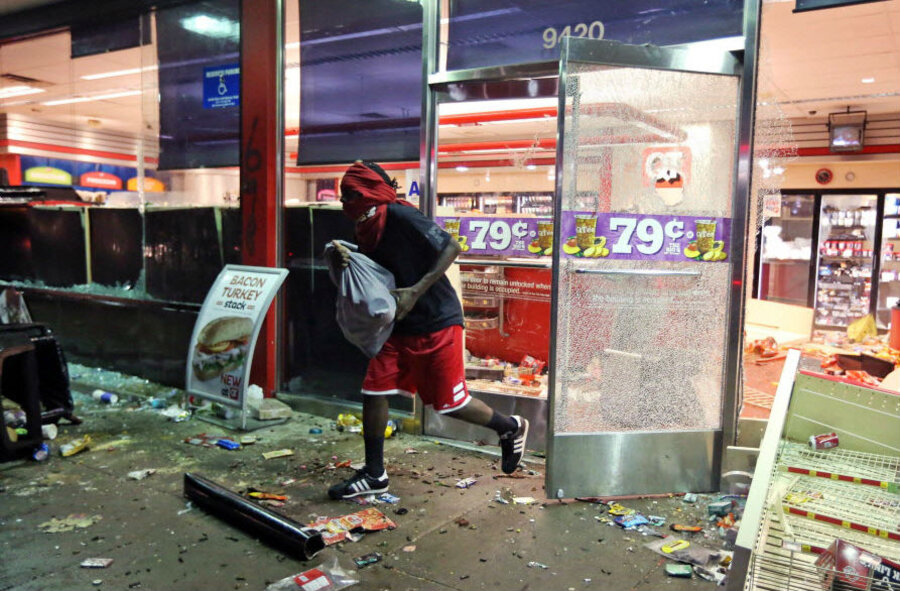FBI to investigate police shooting of unarmed black teen in Missouri
Loading...
Riots and widespread looting erupted Sunday night in a suburb of St. Louis after police in Ferguson, Mo., killed an unarmed black man following an altercation on Saturday. The incident, in which an unidentified officer repeatedly shot Michael Brown, 18, ignited fierce racial tensions between the town’s black majority and its disproportionately white police department.
On Monday, the Federal Bureau of Investigation announced that it has launched an independent investigation of the incident.
While some community leaders have condemned the riots, which have led to dozens of arrests and widespread damage to the area’s businesses, many also have also condemned police, who they say exhibited a lack of professionalism at the time of the shooting and a lack of transparency during the ensuing investigation.
“I find it hard to believe,” St. Louis city councilman Antonio French said of the police’s version of events, to The New York Times. “It’s a textbook example of how not to handle the situation. Ferguson has a white government and a white mayor, but a large black population. This situation has brought out whatever rifts were between that minority community and the Ferguson government.”
According to St. Louis County Police Chief Jon Belmar, the incident occurred when Mr. Brown attempted to grab an officer’s weapon, while both were inside a patrol car. The struggle then continued into the street where Brown was shot “more than just a couple times.”
In response to the incident, hundreds of community members held a vigil Sunday night for Brown at the site of the shooting, many offering prayers. But during the vigil, the crowd spilled into West Florissant Avenue, choking off traffic as looters smashed store windows in the working class neighborhood. Among the first stores looted were a QuikTrip and a Walmart.
Other merchants defended their shops with weapons, leading to armed confrontations with masked hooligans. Gunshots were reported throughout the evening, including some directed at a police helicopter.
Protesters also smashed and destroyed police cars and television station vans, taunting police officers, most of whom stood their ground in a nonconfrontational manner.
The St. Louis Post-Dispatch reported that the violence had calmed significantly by 3:30 a.m. local time on Monday, and as of 9 a.m., police had arrested 32 residents for assault, burglary, and theft. Police said two officers were injured; one was struck by a brick and another suffered knee injuries.
Today, some community members came out against the looting, calling it an ineffective tactic that reflects poorly on Ferguson.
“It sends the wrong kind of message,” Pamela Richardson, who helped clean up the mess Monday, said to the Post-Dispatch. “Don't destroy other people's property that they worked hard for because something else has happened. One doesn't outweigh the other, you know. No connection between the two."
Spokespeople for the NAACP also called for Ferguson residents to act “calmly” in response to the Brown shooting, but expressed concern that a trend is developing of unarmed black men being killed by white police officers.
As a previous example, the organization pointed to the death of Eric Garner, 43, who was put into a fatal chokehold by New York City police officers in July during an arrest for allegedly selling loose, untaxed cigarettes on the street.
“We’re outraged because yet again a young African-American man has been killed by law enforcement,” John Gaskin, who serves on the St. Louis County and national boards of directors for the NAACP.
Since 1999, white policeman across the US have shot and killed at least 18 unarmed black men. Several were cleared of wrongdoing and faced no disciplinary measures, others were fired or suspended for violating departmental guidelines. The most severe punishment befell Officer Joshua Colclough who shot and killed Wendell Allen, 20, in New Orleans in 2012, and was sentenced to four years for manslaughter.
At least five of these incidents led to significant rioting and confrontations with police, including in Portland, Ore.; Oakland, Calif.; and New York City.
In Ferguson, racial tensions between police and residents may have been exacerbated by recent and rapid demographic shifts: In 2000, according to the US Census Bureau, 45 percent of the city’s residents were white and 52 percent were black. By 2010, these numbers had shifted to 29 and 67 percent, respectively.
This report includes material from The Associated Press.





